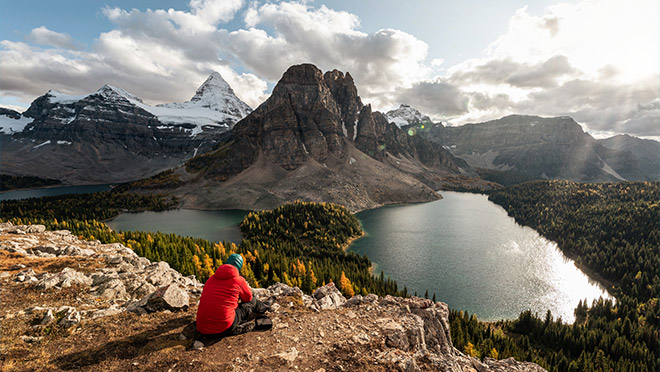10 hiking safety tips, plus how to be FireSmart

Plan well, check the weather, and don't be the one to start a fire
Much of our unseasonably warm May felt like a July. And here we are more than a month down the road, wondering where and when the next wildfire will start. But we're still going on hikes, so let's ensure we're staying safe and doing nothing that could start a wildfire.
Before you go, check for campfire bans, plus restrictions on going into the backcountry. Bans can kick in as lengthy dry weather elevates wildfire risk, and it's worth taking the time to refresh yourself on how to build a safe campfire.
1. Know your route, and let someone know your plan
Print and online trail guides usually offer trail difficulty ratings and estimated completion times, as one 8-km trail can be a whole lot more difficult than another of the same length. Check the weather, especially if you're tackling a high-altitude route, ensure you have enough food, water and other essentials, then let someone who's not going on the hike know exactly when and where you're going.
The leading cause of calls to B.C. search and rescue teams in 2022 was getting lost without a map or navigation device. No. 3 on the list was hikers who chose trails that exceeded their ability, or who were unaware of the trail's difficulty rating.
See the SAR list of the top 10 hiking trails requiring search and rescue.
2. Improve your fitness and your skills
If you're planning a longer or arduous hike, consider doing a little training to up your fitness in advance. And look into getting basic first aid training, which comes in handy more often than you may expect.
B.C. AdventureSmart, a Facebook page run by B.C. search and rescue personnel, is an excellent source of insights, webinar schedules, and videos that can teach you hiking and backcountry basics. Go to AdventureSmart's YouTube page to see helpful videos, including trail-specific tips.
3. Pack the 10 essentials, even in summer
North Shore Rescue's 10 essentials list may strike you as designed for cooler seasons. But guess what? Weather changes quickly, and that comfy hike in a tee can turn into a dangerously chilly overnight stay. A big orange plastic bag may seem like overkill for a summer hike, but it could save your life.
4. Ditch the sandals for proper footwear
You may be able to get away with sport sandals on that short local hike. But if you're heading out on a longer trail, do your feet and your hiking mates a favour. Wear something more sturdy, and resist the temptation to break in a new pair on a lengthy trail. Even a small blister can be a major issue and can really slow you and your group. Include a blister kit in your first aid kit.
In 2022, B.C. search and rescue reported that the second most common cause of emergencies on B.C. trails was poor footwear and/or footing leading to a slip or fall.
5. Book your spot on a popular trail
We're not just talking about booking a trip on the famous West Coast Trail. Hiking has grown in popularity to the point that trail access at Garibaldi, Golden Ears, and Joffre Lakes parks all require reservations. They're free, and you can get them online.
6. Know when to S.T.O.P.
When emergencies, happen, panic can set in. That's the time to S.T.O.P. – Stop, Think, Observe, Plan – to ensure you're making the right decisions. Calm yourself before deciding how to deal with an emergency.
7. If you're in trouble, call 911 immediately
Search and rescue teams want you to call them as soon as you're lost or are in another emergency. Why? Calling 911 immediately (rather than calling a friend or family member) takes advantage of cell coverage, while it's available, and reduces the chance that your phone's battery will die before you get a chance to call. SAR teams can use GPS from your call to triangulate your location and find you faster.
While you wait for help, make yourself easy to find, wear the brightest colours possible, and call out as soon as you hear a searcher nearby.
8. Be bear aware
Bears don't like to be surprised. So especially in the backcountry, use your voice to let bears in the area know you're around. Look for signs that bears are around – HelloBC's bear country essentials tips includes a list of what to look for – and make it a habit to take bear spray with you. And if you do encounter a bear, keep your cool, don't run or yell, and calmly back away slowly. Be ready with your bear spray, but only use it if the animal attacks.
9. Never hike by yourself
There are exceptions, such as on some of the shorter, busy trails in the Lower Mainland. But even if you're a seasoned hiker, resist the temptation to go it alone. Bad stuff can happen to the best of us, and wouldn't you rather share your hike with a friend?
10. Take extra food and water
The amount of food and water you bring shouldn't just be based on what you think you'll need over the course of your planned hike. It should include enough to keep you fed and hydrated if something goes wrong. Generally speaking, about a half-litre of water per hour, per person, should be your minimum. But if you're on an unfamiliar trail or in the backcountry, take more.
Related: